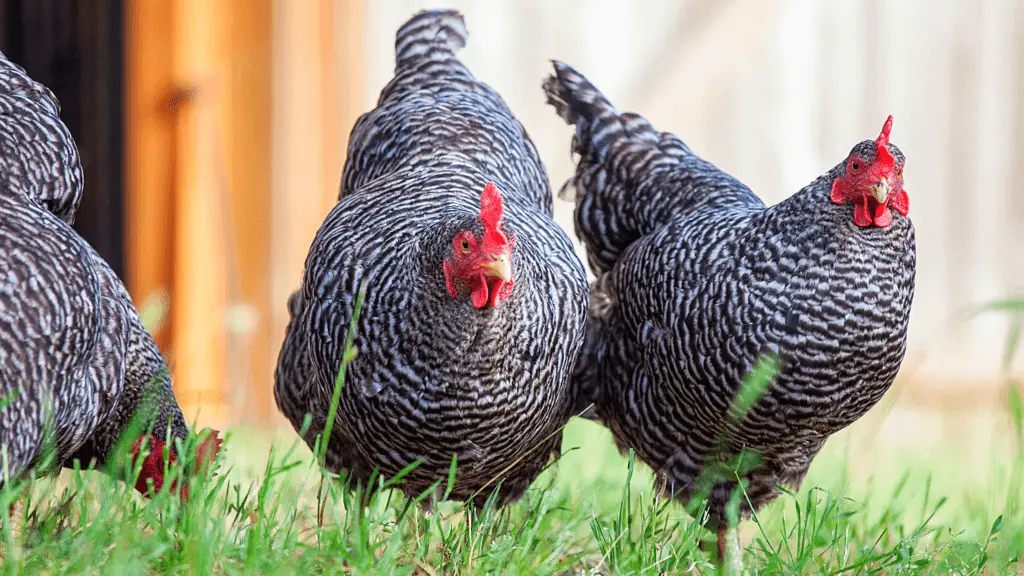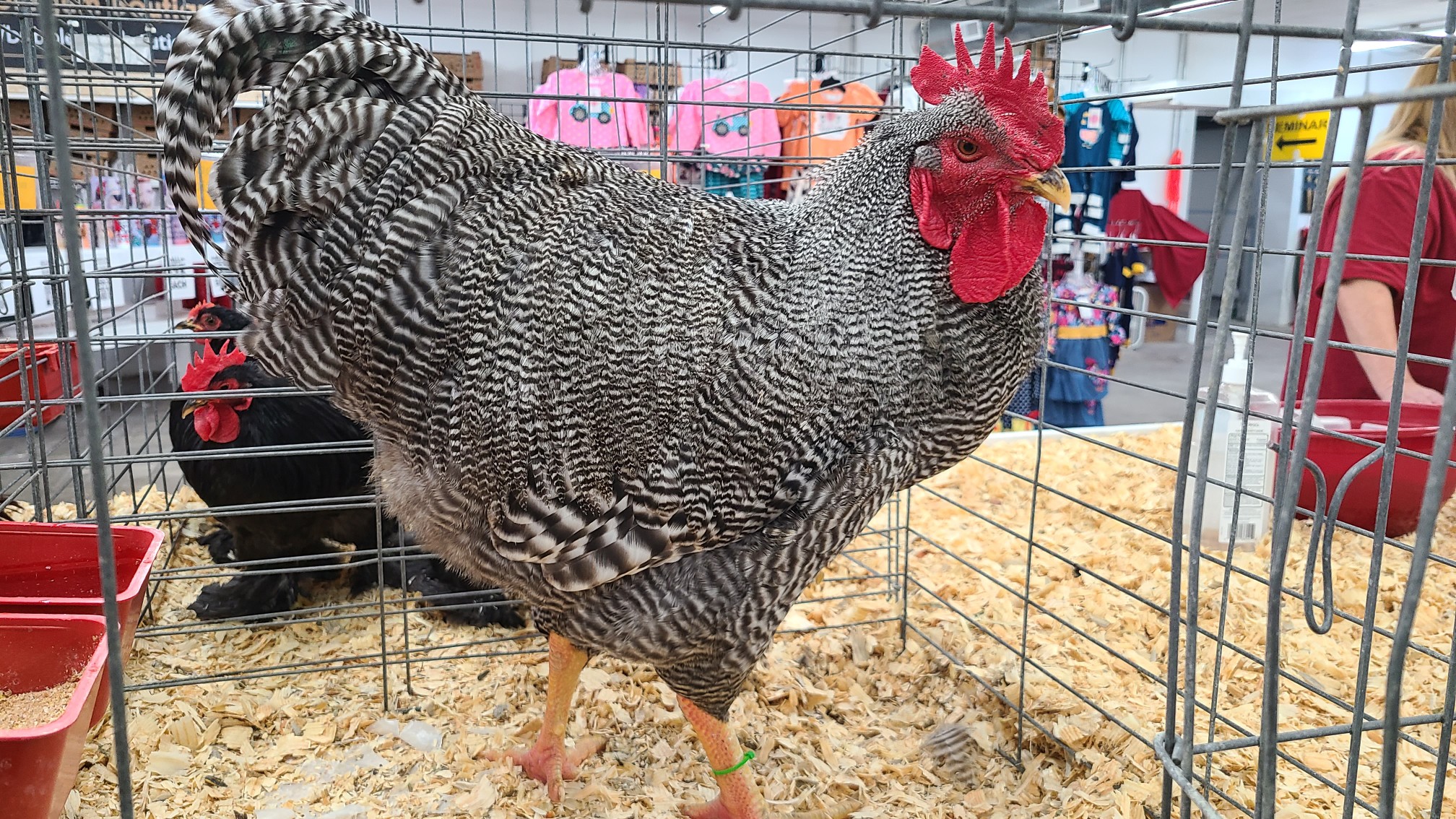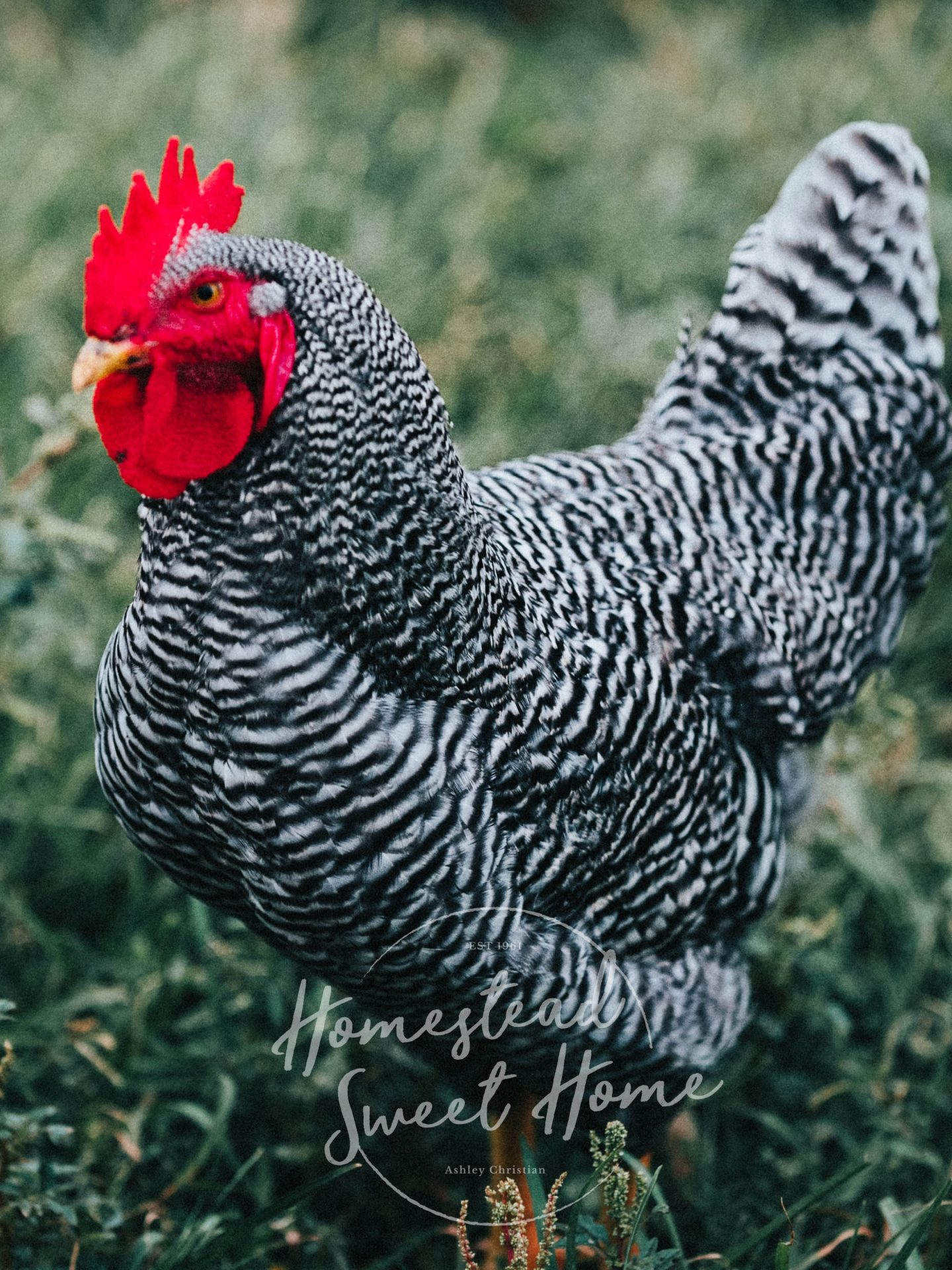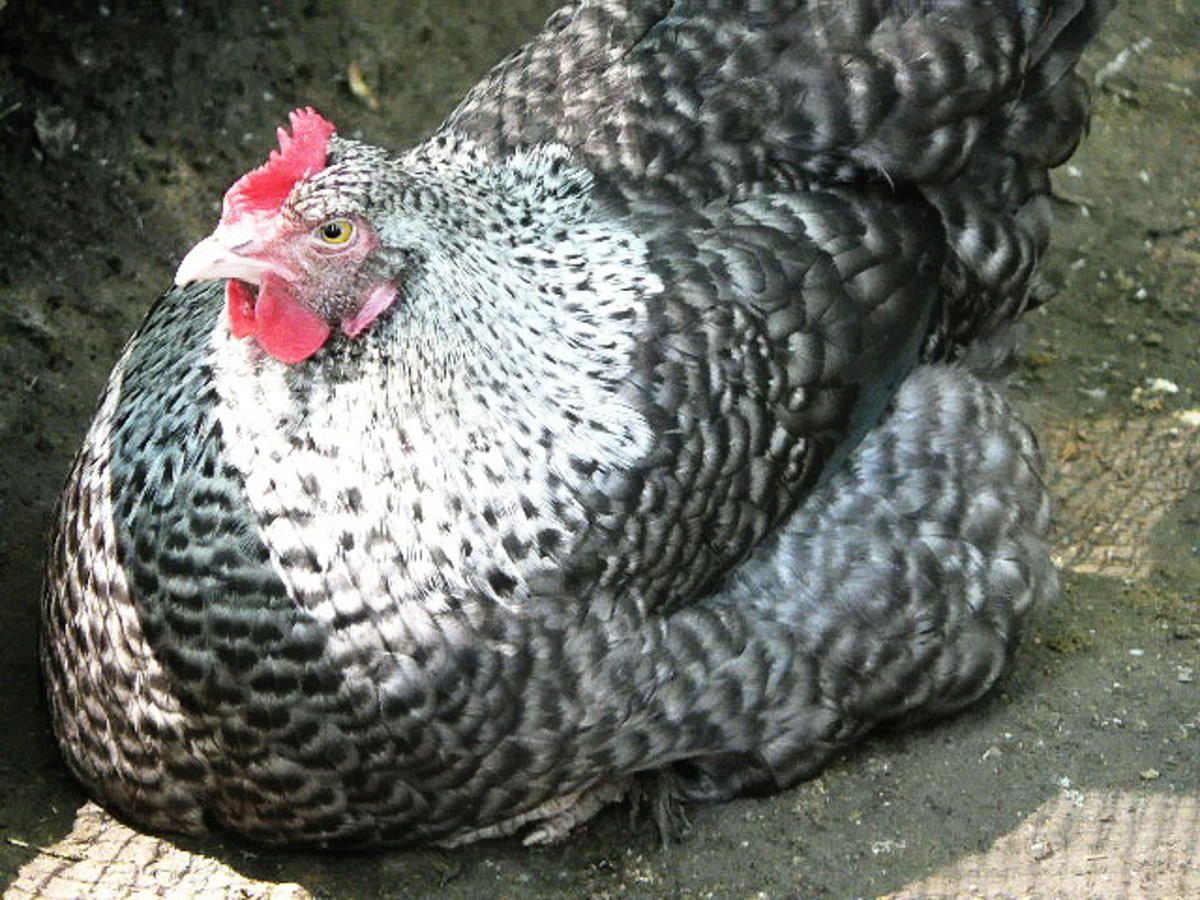The Barred Rock (not to be confused with the Barred Plymouth Rock – BPR) is one of the most popular chicken breeds in the Philippines but unknown to many, of all Barred Rocks in the country, only 20% of them could be possibly true Barred Plymouth Rock. There are many chicken breeds similar to Barred Rock and we are going to explain them below.
The Barred Rock is an American breed of domestic chicken. It was first seen in Massachusetts in the nineteenth century, and for much of the early twentieth century was the most popular chicken breed in the United States. It is a dual-purpose breed, raised both for its meat and for its brown eggs. It is resistant to cold, easy to manage, and a good sitter.
Characteristics
The Barred Rock has a single comb with five points; the comb, wattles, and ear-lobes are bright red. The legs are yellow and unfeathered. The beak is yellow or horn-colored. They have long, broad backs with moderately deep, full breasts. Their feathers are loose compared to other chickens and they lay brown eggs. They are winter-hardy, broody birds that are usually tame and docile but can become aggressive under stressful circumstances. Cocks weigh around 4.3 kgs while hens weigh around 3.4 kgs.
Types of Barred Rock
There are two types of Barred Rock. The hatchery stock and the show type. Both lines have yellow legs and only differ in plumage. Show types are very rare and cost higher than hatchery stocks.
Barred Rocks in the Philippines
As we mentioned about, not all so-called BPRs in the Philippines are true BPR. We’ve seen a lot of similar plumage but have white legs. These birds are mostly coming from Silver Cuckoo Marans and not from BPR.
Here are some of the Barred Rock offered for sale in the Philippines.
This cockerel below is not a true Barred Rock. Although his body structure is that of BPR, he has white legs which are not really for the BPR. He is likely a descendant of BPR and Silver Cuckoo Marans. If someone is offering you this type of BPR, you can buy it if you like him but he is not a true BPR. If he has yellow legs, he is a true BPR.
This is a show-type of pure BPR. If you find another chicken with a similar plumage (feather) but with white legs, it’s not pure anymore. As mentioned, true BPRs either hatchery or show type have only yellow to light yellow legs.
 Below is a pure BPR hen (hatchery stock). If you find something like this and offered to sell, buy her. Take note of the body structure, leg color, and short tail.
Below is a pure BPR hen (hatchery stock). If you find something like this and offered to sell, buy her. Take note of the body structure, leg color, and short tail.
Other Breeds similar to Barred Rock
There are many other chicken breeds that look like BPR but the following are their differences.
Scots Grey
The Scots Grey is a tall, upright chicken. Apart from the height, it is similar to the Scots Dumpy. The Scots Grey has a single comb. The face, wattles, earlobes, and comb are bright red, and the beak and shanks are white, sometimes marked with black.
The plumage is barred. The ground color is steel-grey, and the barring is black with a metallic sheen. Although both sexes are closely similar (apart from secondary characteristics), the markings are larger in hens than in cocks, and may give a tartan appearance.
The Scots Grey is classed as a light breed: cocks weigh about 3.2 kilograms and hens about 2.25 kg
California Gray
The California Gray is an American breed of domestic chicken. It was developed in California in the 1930s by James Dryden, a professor of poultry science at Oregon Agricultural College, now Oregon State University. His aim was to produce a dual-purpose chicken that was both suitable for meat production and laid large white eggs. By crossing a Barred Plymouth Rock rooster and a White Leghorn hen, a naturally autosexing breed with gray barred plumage (as adults) was produced. Largely because the breed was never recognized officially for exhibition by the American Poultry Association, California Grays are a rare breed in the 21st century. It is not listed on the conservation priority list of the Livestock Conservancy.
The California Gray is not sought by commercial factory egg producers since it is too large for battery cages. California Gray cocks are crossed with White Leghorn hens to produce the California White commercial sex-link hybrid, and may be known as “production black”. Most California Greys have white to light-yellow legs with longer tails than the Barred Plymouth Rocks.
Dominique
The Dominique, also known as Dominicker or Pilgrim Fowl, is a breed of chicken originating in the United States during the colonial period. It is considered America’s oldest breed of chicken, probably descending from chickens brought to New England from southern England during colonial times. By the 19th century, they were widely popular and were raised in many parts of the country. Dominiques are a dual-purpose breed, being valued for their meat as well as for their brown eggs. They weigh 2.7 to 3.6 kg at maturity. In earlier times, their feathers were much sought after as stuffing for pillows and mattresses.
Dominiques are quite distinctive in appearance. They have a rose comb and a heavy plumage of irregularly striped dark grey and light grey feathers (a pattern called “barring” or sometimes “hawk coloring”). This dark/light grey striping is often mistaken for black and white striping. The breed matures quickly, producing eggs at about six months of age.
At first glance, Dominiques and Barred Rocks appear strikingly similar, often leading to confusion when discerning a particular breed. The strongest indicators are the comb, plumage, and color.
Silver Cuckoo Marans
The Silver Cuckoo Marans is just one of the ten colors of Marans (white, wheaten, silver cuckoo, golden cuckoo, black, copper-black, silver-black, copper-blue, black-tailed buff, and Columbian). The Silver Cuckoo Marans are the closest thing to Barred Rocks only that they have orange eyes and their shanks are usually slate or pink, the soles of the feet should always be white as Marans have white skin, not yellow. They have distinctive dark brown eggs.
 Scots Dumpy
Scots Dumpy
The Scots Dumpy is a traditional Scottish breed of chicken. It is characterized by very short legs, so short that the body is a few centimeters from the ground; as in other breeds of creeper chicken, this chondrodystrophy is caused by a recessive lethal allele. The Dumpy has at times been known by other names, among them Bakie, Corlaigh, Crawler, Creeper, and Stumpy. There are both standard-sized and bantam Scot’s Dumpies. It is one of two Scottish breeds of chicken, the other being the Scots Grey. Males weigh around 3.2 kgs while females at 2.7 kgs, far smaller than the Barred Plymouth Rock.
There may be other breeds of chicken similar to Barred Plymouth Rock but when buying a BPR, make sure to take note of the following. The legs should be in light to dark yellow, single rose comb, broad body, short tail, and reddish bay eyes (not yellow).
Coom Questions about Barred Plymouth Rock and Barred Plymouth Rock
Are Barred Rock chickens good layers?
Barred Rock chickens are excellent layers. Many of mine lay through the winter. Check out the video below to see a Barred Plymouth Rock hen laying an egg.
What is the difference between Barred Rock and Plymouth Rock?
Barred Rocks are recognizable by their black and white stripes that make them stand out in the flock. Plymouth Rocks are large, hardy dual-purpose birds that have long been preferred for small farms and homesteads, due to their size, productivity, and gentle personalities. Although they have differences, both as considered teh same recently by many breeders and enthusiasts.
What color eggs do Barred Rocks lay?
Barred Rocks are a great breed in terms of temperament and egg-laying. They lay a medium-sized, medium brown colored egg. From experience, our barred rock was by far the most docile and friendly of our standard-size chickens. This is a fairly common breed that is easy to find.
How long do Barred Rocks lay eggs?
Barred will be productive layers for the first few years. Around 3 years of age, they will start to decline in productivity. They will continue laying until 10 years of age, but their egg production will not be as prolific.
How much space does a Barred Rock need?
For heavy breeds, like Barred Rocks or Buff Orpingtons, if you let your chickens out to forage during the day, then the coop that you put them in at night should have at least 4 square feet of space per bird. Thus, a 4′ by 8′ coops would be adequate for about 8 birds.
Are Barred Rock chickens noisy?
If you have a small backyard enterprise and want a quiet, docile, friendly egg layer, the Barred Rock may be your bird. They are not very noisy (except for the egg song) and would make a good addition to an urban flock. They adequately provide the egg department for a mid-sized family, and hens will reach around 7.5lb
What’s the difference between Barred Rock and cuckoo Maran?
It’s not easy to tell the difference between a Barred Plymouth Rock and a silver Cuckoo Marans. The “cuckoo” type of the latter bird doesn’t refer to sound or personality, but to the barred feather pattern.
How can you tell if a Barred Rock is male or female?
Barred Rocks are born with a spot on their heads, and this spot is key to sex linking — a male has a large white spot, while a female has a smaller narrower spot. In general, female Barred Rocks are also lighter colored than males.
Can Barred Rock chickens fly?
They are poor flyers, so you don’t need to have a huge fence around their enclosure to keep them in, as they are unlikely to go and investigate the neighbors’ yards unless they can walk there. Speaking of neighbors – the Barred Rock is said to be a quiet but talkative chicken.
Do Barred Rocks go broody?
Because Barred Rock chickens are a heritage breed, they tend to go broody. When the breed was first developed, modern incubators didn’t exist, so to hatch chicks, a broody hen was required.
At what age do Barred Rocks start laying?
Expect your barred rock pullet to start laying eggs when she is about 16 to 20 weeks old. Once she begins laying, she should produce one egg every 25 hours – except during the cold, dark hours of winter when she may not lay at all — until her first molt a year later.
How cold can Barred Rock chickens tolerate?
Cold weather chickens can withstand temps around or slightly below freezing (32 degrees Fahrenheit to about ten degrees Fahrenheit).
Where to Buy Barred Plymouth Rock in the Philippines
BPR is one of the most popular breeds here and although there is a massive shortage of heritage chicken, you can get one from Facebook Groups if you take the time to search and connect with other backyard breeders. You may also check our free-range chicken farms directory.
See Also: